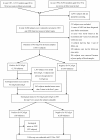Fluctuations of epstein-barr virus serological antibodies and risk for nasopharyngeal carcinoma: a prospective screening study with a 20-year follow-up
- PMID: 21544243
- PMCID: PMC3081347
- DOI: 10.1371/journal.pone.0019100
Fluctuations of epstein-barr virus serological antibodies and risk for nasopharyngeal carcinoma: a prospective screening study with a 20-year follow-up
Abstract
Background: The impact of variation of Epstein-Barr virus (EBV) antibody titers before the development of nasopharyngeal carcinoma (NPC) is still unclear. We analyzed the fluctuations of antibodies against EBV before histopathological diagnosis to assess the risk of NPC and aimed to provide a reliable basis for screening in high risk populations.
Methods: This study was based on a population-based screening program in Sihui County in Guangdong Province of China. A total of 18,986 subjects were recruited in 1987 and 1992, respectively. Baseline and repeated serological tests were performed for IgA antibodies against EBV capsid antigen (VCA/IgA) and early antigen (EA/IgA). Follow-up until the end of 2007 was accomplished through linkage with population and health registers. Cox proportional hazards regression model was used to estimate the relative risk of NPC in association with EBV antibodies. Time-dependent receiver operating characteristic curve (ROC) analysis was used to further evaluate the predictive ability.
Results: A total of 125 NPCs occurred during an average of 16.9 years of follow-up. Using baseline information alone or together with repeated measurements, serological levels of VCA/IgA and EA/IgA were significantly associated with increased risks for NPC, with a striking dose-response relationship and most prominent during the first 5 years of follow-up. Considering the fluctuant types of serological titers observed during the first three tests, relative risk was highest among participants with ascending titers of EBV VCA/IgA antibodies with an adjusted hazard ratio (HR) of 21.3 (95% confidence interval [CI] 7.1 to 64.1), and lowest for those with decreasing titers (HR = 1.5, 95% CI 0.2 to 11.4), during the first 5 years of follow-up. Time-dependent ROC analysis showed that VCA/IgA had better predictive performance for NPC incidence than EA/IgA.
Conclusion: Our study documents that elevated EBV antibodies, particularly with ascending titers, are strongly associated with an increased risk for NPC.
Conflict of interest statement
Figures





References
-
- Parkin DM, Bray F, Ferlay J, Pisani P. Global cancer statistics, 2002. CA Cancer J Clin. 2005;55:74–108. - PubMed
-
- Chang ET, Adami HO. The enigmatic epidemiology of nasopharyngeal carcinoma. Cancer Epidemiol Biomarkers Prev. 2006;15:1765–1777. - PubMed
-
- Saika K, Sobue T. Comparison of time trends in cancer incidence (1973–2002) in Asia, from Cancer Incidence in Five Continents Vols IV-IX. Jpn J Clin Oncol. 2008;38:872–873. - PubMed
-
- Yu MC, Yuan JM. Epidemiology of nasopharyngeal carcinoma. Semin Cancer Biol. 2002;12:421–429. - PubMed
Publication types
MeSH terms
Substances
LinkOut - more resources
Full Text Sources
Other Literature Sources
Miscellaneous

